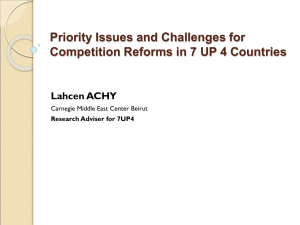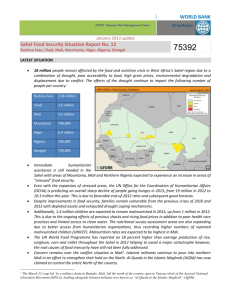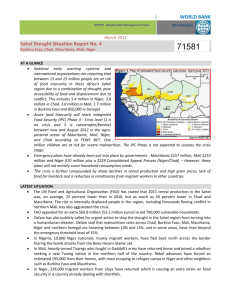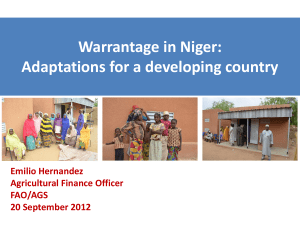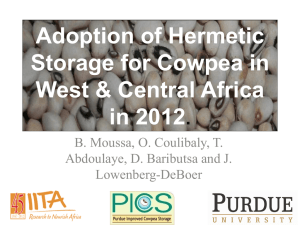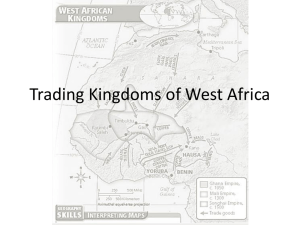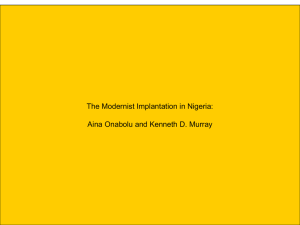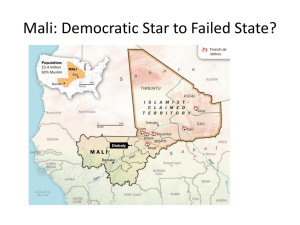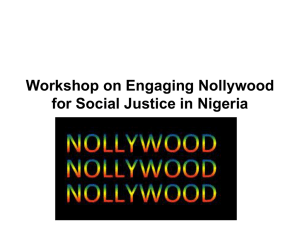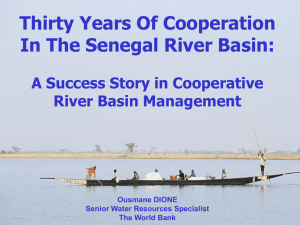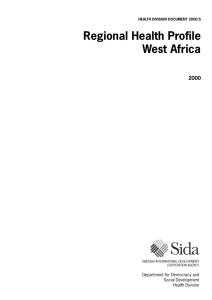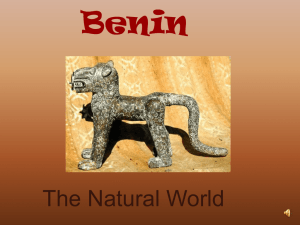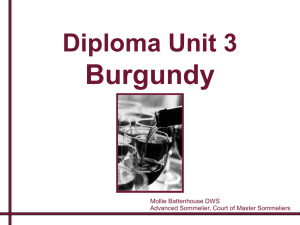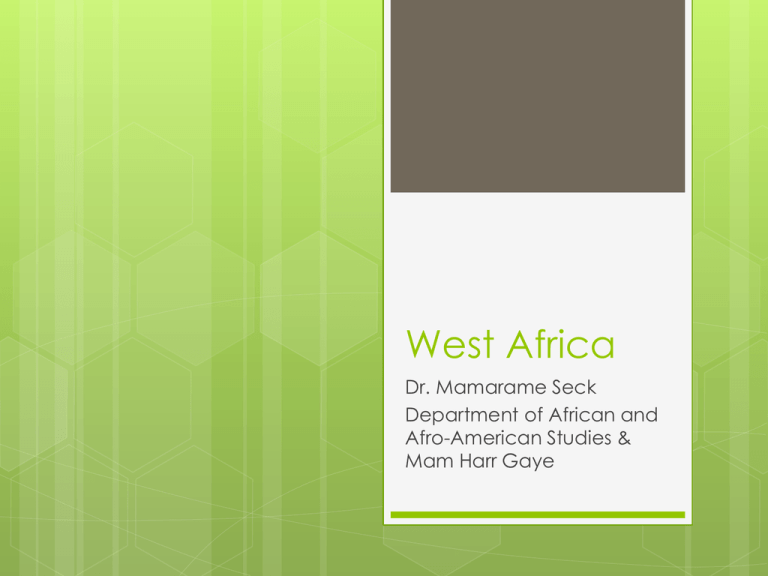
West Africa
Dr. Mamarame Seck
Department of African and
Afro-American Studies &
Mam Harr Gaye
An Introduction
Countries (17)
Chad
Niger
Nigeria
Mauritania
Mali
Senegal
Guinea
Sierra Leone
Gambia
Guinea Bissau
Liberia
Ghana
Togo
Benin
Burkina Faso
Côte d’Ivoire (Ivory Coast)
Cape Verde
West Africa Today
Progress in the
Present
Poverty and Conflict
One of most
underprivileged areas in
the world based on:
Gross National Product (GNP)
Human development
Recent Conflicts
Liberia, Sierra Leone (19902003), and Guinea (1990 –
2010)
Côte d’Ivoire: Civil war (20002004-2011)
Both situations are still cause
for concern
Fair and free elections
Ghana Stock Exchange regularly
tops the list of the world’s highest
performing market
Urbanization in cities
Dakar (Senegal)
Lagos (Nigeria)
Economic Community of West
African States (ECOWAS): promotes
cooperation, economic growth,
and integration
Exports
Energy products (oil)
Minerals (gold, diamonds, bauxite)
Agricultural Goods (cocoa, coffee,
groundnuts, cotton)
Physical Features
South and West → Atlantic Ocean
North → Sahel (Sub-Saharan)
Southeast → Adamawa Highlands of
Cameroon
Plateaus cover much of West Africa
Major Rivers
Easily accessible made trade and
communication feasible from an early
time
Agricultural and economic centers
Heavily populated
Highlands
Emi Koussi (11,204)
Rivers and Lakes
Coastal Lowlands
A Volcano Tibesti Mountains (Chad) →
Highest Peak in West Africa
Major Lakes
Peaks over 6,000 feet: Aïr Mountains
(Niger)
Cape Verde Archipelago (Africa’s
westernmost point)
Lake Chad
Islands
The Niger River – one of the longest in the
world (Nigeria, Niger, Benin, Mali, Guinea)
The Gambia
The Senegal
The Casamance (Southern Senegal)
The Volta (Ghana, Burkina Faso)
The Benue (Nigeria)
Seasonal Rivers
Shrinking due to irrigation, overgrazing, less
rainfall, and a growing population
Inner Delta of Niger River (Mali)
Lake Volta (Ghana)
Lake Kossou (Côte d’Ivoire)
Kainji Lake (Nigeria)
Map of Physical Features
People of West Africa
(Population Density Map)
Different Ethnic Groups of
West Africa
Akan – Ghana, Côte d’Ivoire
Dogon – Mali
Ewe – Togo, Benin, Ghana
Fon – Benin, some Togo
Fulani – Nigeria, Guinea,
Burkina Faso, Senegal, Mali,
Cameroon, Niger, Benin,
Gambia, Guinea-Bissau, Sierra
Leone, Central African
Republic
Hausa – Nigeria, Niger, Sudan
Igbo – Nigeria
Kanuri – Nigeria, Niger, Chad,
Cameroon
Mande – Mali, Guinea, Côte
d’Ivoire, Sierra Leone, Liberia,
Burkina Faso, Senegal,
Gambia, Ghana, GuineaBissau, Nigeria, Benin,
Mauritania
Mende – Sierra Leone, Liberia
Moors – Mauritania, Mali
Mossi – mainly Burkina Faso
Songhai – Niger, Mali, Niger,
Benin, Burkina Faso
Tuareg – Algeria, Burkina Faso,
Libya, Mali, Niger
Wolof – Senegal, Gambia
Yoruba – Nigeria, Benin
Languages
Lingua Francas
French
approximately half of West
Africa
English
Gambia
Ghana
Liberia
Nigeria
Sierra Leone
Portuguese
Guinea Bissau
Cape Verde
Arabic
Mauritania
Indigenous language Families
Religion in West Africa
Three main divisions:
Christianity
Brought around 1450 C.E. by European merchants
through the West African Coast
Worshippers concentrated by the coast
Islam
Brought around 750 C.E. by Muslim Berber and Arab
traders from North Africa
Worshippers concentrated in North near Sahara
i.e. Ghana has ~66% Christian following
i.e. Mali has 90% Islam following
Indigenous African Religions
i.e. Benin 50%, Burkina Faso 40%, Liberia 40%, Togo 51%
Guinea-Bissau 50%
Christianity in West Africa
Progression through the centuries
Came in the 15th century, brought by Portuguese sailors
In the 18th century, returning British and Caribbean slaves spread
Christianity
Europeans and Americans create mission stations in the 19th
century
Modern Practice
After colonialism, began incorporating more African aspects
into worship
Use of African music and instrumentation for singing hymns
Broad spectrum of Christianity
Roman Catholic
Protestant
African Independent Churches
Islam in West Africa
Progression through the centuries
7th century – Islam spread to most of North Africa
10th-12th centuries – Sahel rulers convert
13th-17th centuries – Mission activity flourishes thanks to
Fulani and Mande efforts
1804-62 – jihads by the Fulani lead to development of
three important empires:
Sokoto caliphate (Nigeria)
Tukulor caliphate (Senegal)
Macina empire (Mali)
Sufi brotherhoods (i.e. Senegal, Gambia, Mauritania,
Nigeria)
2000 – six northern Nigerian states introduce sharia law
Indigenous African Religions
Single creator-god and many spirits
Ancestral spirits
Spirits associated with sacred sites where rituals are held
Pay respects in various ways
Help watch over community
Cross-currents
As Islam and Christianity were introduced, many Africans began to incorporate
both aspects of the religion they converted to (Syncretism)
Some decline of indigenous beliefs
Resisted the outer influence
Moors
Fulani
Hausa
Fon of Benin
Mende of Sierra Leone
African indigenous beliefs in African Diaspora
Caribbean – Yoruba slaves brought about Santería, a mix of Yoruba deities and
Roman Catholicism
Haiti – Vodun brought in by the Fon
Trinidad, Grenada, and Brazil – Shango
Society and Culture
Meeting & greetings
social distance
invitations
conversational etiquette
sensitive subjects
Major holidays/ceremonies
Religious
Secular
traditional
Taboos
Major holidays/ceremonies
Religious
New Year’s Day Jan 1
Ashura (First of day of the Muslim calendar)
Prophet Muhammad’s Birthday
Easter Sunday and Easter Monday
Assumption Day Aug 15
Eid Al Fitr or End of Ramadan
All Saints’ Day Nov 1
Eid Al Adha (Sacrifice of Abraham)
Christmas Day Dec 25
Secular
Independence Day
Labor Day May 1
Women’s Day
Major holidays/ceremonies
Traditional
holidays vary according to the
country.
Ghana: Aboakyer Festival (Deer Hunting
Festival) May
Homowo Festival (Yam Festival)
Senegal: Initiation among the Sereer and
Diola, Baawnaan among the Wolof (when
the rainy season is delayed)
Meeting and Greetings
In more traditional settings, greetings are distinguished by a
very long hand shake, to be maintained during a full
discussion of your health, your general state of mind and
the weather.
This is a formality; always respond that everything is fine. In
cities however, greetings may be shorter. Use a gentle grip
for all handshakes.
Always use only the right hand. Avoid eye contact with
someone of superior rank or with a member of the opposite
sex.
In a group, shake hands with every person present, both on
arrival and departure. Use surnames and professional titles,
preferably in French. When a man is greeting a woman, he
should wait for her to extend her hand first.
Meeting and Greetings
It is considered impolite not to greet someone you
know as you pass them on the street.
For an added level of respect, a slight bow is often
performed along with the handshake.
In Muslim-dominant countries local Muslim men
and women do not normally shake hands or
otherwise have physical contact when greeting in
public.
Direct eye contact is usually reserved for previous
acquaintances, and elders should not be
subjected to direct eye contact until a firm
relationship has been established.
Taboos
Avoid pointing at people with your index finger,
use the whole hand instead.
Giving anything to someone with the left hand is
considered very rude. Always give and receive
object with the left hand.
Using your right hand to shake, touch, eat food
with, or handle money (or anything else) is a must.
Using the left hand for these things is considered
rude and dirty
When eating out of a communal bowl, don’t take
meat or veggies from the other side.
Passing gas in public is considered rude.
Taboos (Cont.)
Avoid
clothing that exposes your body
Modest clothing for both men and
women is recommended, particularly in
more rural areas.
Architecture
Great Mosque
(Djenné, Mali)
Emir’s Palace (Kano,
Nigeria)
Friday Mosque (Zaria,
Nigeria)
Djinguereber Mosque
(Tombouctu, Mali)
Tomb of Askia
Muhammad (Gao,
Mali)
Great Mosque
(Agadez, Niger)
Basilica of Our Lady of
Peace
(Yamoussoukro, Côte
d’Ivoire)
Activities
Scenario
You arrive in a Muslim-dominant country in
West-Africa (Senegal, Mali, etc.) and
schedule a meeting on Friday around 2PM.
But to your surprise, people start showing up
at 3PM without presenting any excuses. What
will be your attitude towards the attendees?
Why do you think they did not present their
excuses to you?
You are being introduced to some elderly
people in a village. How do you greet them?


